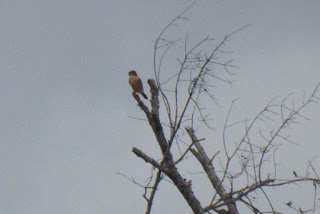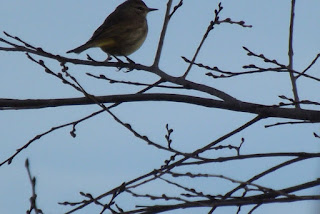For many birders, the hobby of birding is at its best in the
springtime. While you head out into the
field, the observer of the changing landscape with all its fresh, different
sights, there will be transient birds migrating through, new residents staking
out territory, early breeders busy at their nests, and winter visitors moving
on north. This is clearly one of the
best times to survey the vast numbers of bird life on this continent and make a
useful contribution to science. This is
the idea behind the North American Migration Count—which is held on the second
Saturday of May. Although this date
falls later than the peak of spring migration for the Southeast, there should
still be plenty of migrating birds moving through. Migration counts may be conducted by teams of
birders or individuals, but each count area must be confined to a single
county. All wild birds within the count
area may be included in the tally, and the counting procedure is very simple
and straightforward—like that of the Christmas Bird Count.
I was a teenager when I first participated in the North
American Migration Count. The Oktibbeha
Audubon Society asked me to survey a route in the southeastern part of the
county. My dad and I headed out on our
route at about 9:30 a.m., hitting the Bluff Lake levee first to tally any herons, egrets
or songbirds that crossed over into Oktibbeha County. The morning was warm and muggy but full of
birds. Very quickly we picked up Acadian
Flycatcher, Common Yellowthroat, Yellow-throated Warbler, Great Crested
Flycatcher, Eastern Kingbird, Prothonotary Warbler, White-eyed Vireo, Indigo
Bunting and many other species in the woods, including a Ruby-throated
Hummingbird feeding from Trumpet Creeper blossoms. We heard a Fish Crow and also counted many
egrets flying overhead, a couple of Wood Ducks, and one Great Blue Heron, which
surprisingly, would turn out to be our only one all day. Just as we were leaving the area, I glimpsed
a group of three large birds flying high overhead—White Ibises.
 |
| Prothonotary Warbler |
We drove a little down the road, looking and listening for
some of the forest species such as Red-eyed and Yellow-throated Vireo, Pileated
Woodpecker, Eastern Wood-Pewee and Yellow-billed Cuckoo. By now our list was around 40 species. There were good numbers of singing Yellow
Warblers, and I could make out two Northern Parulas trilling close by. As we got out to walk a trail that cut
through the woods, there was a harsh chittering overhead, which alerted us to
about two dozen Chimney Swifts circling.
These were probably natural-nesting swifts, choosing a hollow tree over
a manmade chimney.
The woods were mostly deciduous, with tall pines mixed in
here and there. There were also many
deep puddles of muddy water from a recent rainfall. Pine Warblers, chickadees, titmice, towhees,
and vireos noisily proclaimed their territories in the dense woods, seeming
almost indignant at us traipsing through their home. I accidentally flushed a Cooper’s Hawk from
its roost. It flew away, disturbing the
singing birds for a few minutes. I heard
White-breasted Nuthatches in the distance and saw a pair of Summer Tanagers in
the trees. Bird songs were not all that
we heard: Gray Treefrogs were also
making their presence known in the forest with low-pitched croaks.
 |
| Cooper's Hawk |
I had just commented to my dad on the odd absence of
Kentucky Warblers, when one in a thicket burst emphatically into song. A Hooded Warbler added its short,
eight-syllable whistle to the other sounds of the forest, while wrens and
skinks scuttled through the thickets and leaf litter, the wrens putting in a
word now and then, unlike the lizards!
There was a creek by this trail where we were likely to find Louisiana
Waterthrushes, and in the trees near it, American Redstarts. Unfortunately, neither species showed up for
us, and eventually we moved on, making a mental note to come back to the trail
later.
We went up Oktoc Road for more counting. The habitat here was mostly thickets, fields
and pastures, with scattered trees, which meant a whole new group of species
for us. Bluebirds and kingbirds perched
on the wires; grackles and blackbirds foraged in the pastures. We were able to add Red-headed Woodpeckers
and many more Cattle Egrets to the tally.
Eastern Meadowlarks, Orchard Orioles, Barn Swallows and Purple Martins
also put in appearances. Overhead, there
were vultures, Red-tailed Hawks and a Green Heron that flew from a small
pond. A little farther down the road, I
heard a loud ringing song coming from a thicket—a Swainson’s Warbler. I listened to the recording on my audio field
guide back in the car; no doubt about it:
the song was a Swainson’s Warbler’s.
Since this is a fairly scarce bird, I wrote down the location, including
the mailbox number, and we headed on.
We came to a place down the road where mixed forest grew on
one side and young trees and shrubs were just coming up on the other. Almost immediately our ears picked up
Northern Bobwhite, Yellow-breasted Chat and one Prairie Warbler. A few more Kentucky Warblers and Indigo
Buntings sang loudly, and I spotted another Summer Tanager pair. Then I noticed something lower down in an oak
tree. I investigated with binoculars and
found myself looking at a beautiful male Scarlet Tanager, just sitting on a
limb in a little shaft of sunlight, his jet-black wings and tail contrasting
with the bright-red of his body. What a
treat!
 |
| Scarlet Tanager |
We still had to head through Starkville, so after tallying, we drove on. While in town, we saw plenty of House Sparrows and European Starlings and two Eurasian Collared Doves. Our next stop was a sewage lagoon where we supposed to locate a few ducks and shorebirds. As we began walking around the pond, we flushed bunches of Red-winged Blackbirds and saw Northern Rough-winged Swallows overhead, but the edge of the pond, choked with weeds, just didn’t look promising for sandpipers. Farther up, however, we noticed the drastic difference in the habitat. There were obvious mud flats with shorebirds feeding. Three Solitary and one Spotted Sandpiper dotted the bank with several Killdeer, too. We saw two Blue-winged Teal, a pair of Canada Geese with four large fuzzy young, and thirteen Wood Ducks—two adults and eleven ducklings.
The count list was pretty big so far, but I did notice that
we were missing a few birds. We managed
to find some Blue Grosbeaks by retracing our route and only counting species
that were new to us, not ones we’d counted already. We managed to hear a flock of Cedar Waxwings
this way, and then went to search again for the redstarts and waterthrushes.
The woods were a lot quieter now; it was about 4:00 p.m. and
I doubted that we’d see the elusive species we were looking for. Although we didn’t pick up any new birds
while we were there, we did see other wildlife.
Butterflies fed on the flowers, Ichneumon wasps flew up from the grass,
and a Southern Leopard Frog was in one of the puddles. My dad was pleased to observe a Toad Bug that
I located near another pool of water. We
watched it as it hopped about, its coloration blending in amazingly well with
the gritty mud of its habitat.
Back in the car, we counted up the species we had found
during the day: seventy-six, and
hundreds of individuals all over. It had
been a great count. We were both
exhausted but filled with a sense of accomplishment and exciting memories of
that spring day.
Even if your schedule doesn't permit you to count every bird that you see for an entire
day, it’s still worthwhile to spend some time marveling at the diversity of
species during this fascinating season!

.jpg)
.jpg)





_1.jpg)
_2.jpg)
_3.jpg)
_4.jpg)
_5.jpg)
_6.jpg)

























